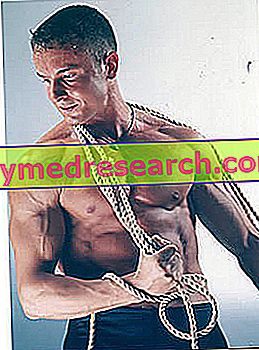Muscle strength is the motor capacity that allows us to overcome a resistance or to oppose it through the development of tension on the part of the musculature.
By trophism, however, referring to the very young, we mean the possession of a well-structured and balanced tonic musculature between the various segments of the body.
The main determinants of muscle strength are:
- the transverse diameter of the muscles (2-3 kg per cm2 of transverse area)
- the number of fast fibers
- the ability to recruit motor units
- muscle coordination, understood as the ability to work in synergy with the antagonist muscles and the agonists with movement
- the initial length of the muscle
- the number of recruited motor units (the smaller motor units are activated first, see figure)
 |  |  |
| Click on the images to enlarge | Representation of recruitment phenomena in the Fukunaga 1976 increase in force | |
| Characteristics of the human body that influence the production of strength | |
| Immutable features: | Improved features: |
Type of muscle fibers Pennation angle Point of insertion of tendons Kinematic characteristics of the joints | Transverse muscle section (hypertrophy) Fiber recruitment Intra and intermuscular coordination Factors related to stretching |
There are three basic forms of force:
- Maximum strength
- Resistant force
- Fast or fast force
Maximum strength: it is the highest force that the neuromuscular system is able to develop with a voluntary contraction
Resistant force (resistance to force): the body's ability to resist fatigue during strength and / or duration performance.
Rapid or fast force: it is the ability of the neuromuscular system to overcome resistance with a high rate of contraction
Work out
In general, methods for developing strength are achieved through the use of an external resistance, which causes adequate tension in the muscle.
The means for developing strength are numerous and include:
- body attitudes, designed to increase exercise intensity
- elastic objects
- changes in external characteristics (running uphill, on sand ...)
- use of gravity and inertia
- overload
A low number of high intensity repetitions acts on the maximum force.
A high number of repetitions at low loads acts instead on the resistant force.
Finally, loads of the same size for 4-8 repetitions at maximum speed develop fast force.
Static or isometric muscle exercise:
A constant muscle length.
Static:
- there is no movement therefore mechanical work is lacking.
- missing movement (acceleration = 0) therefore the resisting force is the same as the applied one
To set up the workout you play on the duration of exercise.
Non-isometric or dynamic muscle exercise
The length is changed, there is movement.
It can be isotonic or isokinetic
In the isotonic exercise one has dynamic exercise with shortening of the muscle and displacement of a weight or a constant resistance. However, this is a relatively theoretical event since the resistance tends to vary over the course of the movement.
Isokinetic muscle exercise is performed at a constant angular speed throughout the movement. The machines for isokinetic training modify the resistance produced by the dynamometer proportionally to the force exerted by the muscle, so that a maximum load can be applied at any point of the arc of movement.
Muscle Power
Power expresses the explosive aspects of force and is given by:
Power = Strength / Time
In other words, the muscular power of a subject tells us how much he can move in a unit of time.
With the same load lifted in a maximum relaxation on a flat bench (weight = 100Kg) Kevin is more powerful than Ronnie if he does the movement in less time.
Muscular resistance
Muscle endurance tells us how much strength an athlete can develop in a certain period (how much strength, how long).
In other words, this parameter indicates the number of repetitions that can be performed with a given load, expressed as a percentage of the maximum force (1-RM).
If Carlo manages to do a 200 kg squat repetition and 10 repetitions with 150 kg he is stronger, but less resistant than Mario, who has a ceiling of "only" 190 kg but can do 12 repetitions with 150 kg.



